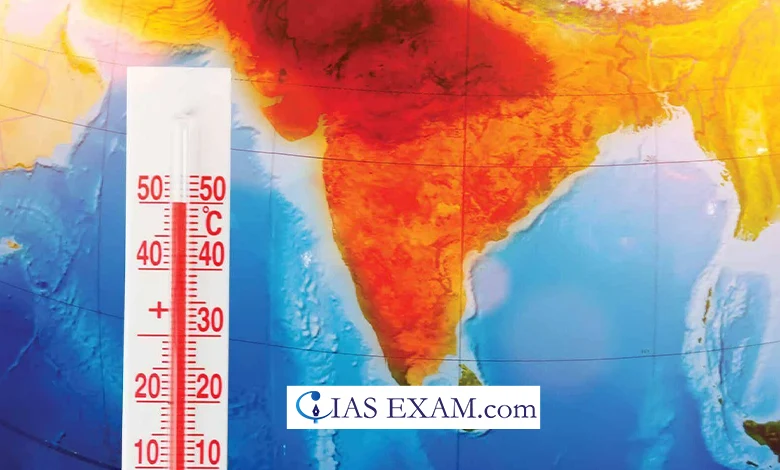Daily Current Affairs for UPSC
India’s Heat Action Plan
Syllabus: Disaster Management [GS Paper - 3]

Context
In recent days of this year, the scorching heat waves across the country has gained a lot of attention and India’s Heat Action Plan is aiming to mitigate this disaster in the best possible way to reduce fatality and disaster to the lives and resources.
All about Heat Wave
- Heat wave means an unexpected, long lasting and above the normal heat that causes the unusual maximum level to rise.
- Most of the time the occurrences happen around March and June, mainly June.
- The “heats” in the northern area are predicted to be around five or six times greater.
- Criteria is the qualifying or more specific weights/information that is needed to assess or evaluate something.
- The plains are said to be affected by the heat wave when the temperatures go above 40°C, while in the hills, temperatures of at least 30°C are mandatory.
- Occurrence of immission decomposition and transportation effluents of compounds that do not mind the expected pattern.
- A single day of heat wave could potentially push temperatures up by 1 degree Celsius to 1 degree Celsius above normal.
- The temperature is accordingly increasing to 6.40°C or higher.
- The team that divides the community into sections will be based on the greatest recorded temperature.
- A heat wave is a condition when a normal or more high temperature is observed, it is above 45°C.
- The temperature may hit as high as 47°C in such a heat wave scenario.
- Affecting health comes in the form of physical and mental effects on individuals.
- Alteration of temperature may confuse the bodily apparatus responsible for the body regulation of temperature which will impair its regulation of the same.
- Heat-related illnesses, including heat cramps, heat exhaustion, heat stroke, and hyperthermia, are also common in high-temperature environments.
What are the Heat Action Plans and Recommendations
Heat Action Plans (HAPs)
- Designed by governments at different tiers of governance which are State, District, and City.
- Commend the drawbacks related to heat waves.
- They are not owned by a central authority; at least 23 HAPs (Heads of Astrophysics Programs) were identified.
How HAPs Work
- Scrolling through historical heat events of the region, the application should supply specific information of past events and heat profiles.
- Regularly carry out vulnerability assessments in order to determine and mark safe places.
- Lay out responsibilities of the particular departments and also identify the plan of the action.
Recommendations
- Use forecasting and warnings to disseminate information to the public on what the weather will be like.
- Create shade, cooling spots, and green spaces. Bring water.
- Enlist hospitals to follow evacuation procedures relating to heat-induced illnesses.
Long-Term Measures
- Encourage more city trees to reduce the heat and temperature.
- Implement heat-resistant construction materials to decrease the role of urban heat islands in our environment.
- Pave cool roofing technologies as a means to maintain lower indoor temperatures.
Hindrances for Heat Action Plan
- People may lose function of heatwaves reports even though the urban areas are exposed to great heat.
- Assessments of vulnerabilities in HAPs experiencing multiple medical problems lack a systematic and consistent approach.
- HAPs stem from vulnerable populations but are incapable of what only target interventions can.
- HAPs implementation is dependent on the location of a city. The local priorities and capacities therefore play a major role in the decision process.
- Merging HAPs with the comprehensive districts’ plans would achieve the goals of optimising all the resource uses.
Conclusion
- India’s Heat Action Plan is designed to protect not only human lives but also resources which are to be destroyed by severe heat waves. With warm weather spikes increasingly hitting us, the scheme’s attention to early alerts, public education and infrastructure build-up will be important.
- Nevertheless, the performance of the bearing ability of the system is limited by two major problems – inconsistent critical asset analysis and divergent implementation approaches.
- Integration of Heat Action Plans with varying district plans is necessary for the performing of more tasks and building stronger defence systems against heat related catastrophes, providing protection to the whole country.
Source: The Hindu
UPSC Mains Practice Question
Q. Discuss the significance of India’s Heat Action Plan in mitigating the impact of heatwaves on communities. Evaluate the challenges faced in its implementation and suggest measures to enhance its effectiveness.





.png)



